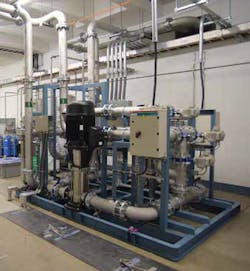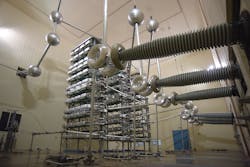Originally constructed in 1978, Great River Energy’s high-voltage direct-current system is one of a few of its kind in the world and one of the electric generation and transmission cooperative’s most valuable assets. The co-op’s high-voltage direct-current (HVDC) system consists of a 436-mile (702-km) HVDC transmission line and two converter stations, one at each end of the line, that convert electricity from alternating-current (AC) power to direct-current (DC) power and vice versa. Nearly all the power is delivered from Coal Creek Station — the co-op’s largest power plant — in Underwood, North Dakota, U.S., to Minnesota, where the utility’s 28 member co-ops are located.
After eight years of planning and preparation, Great River Energy recently upgraded the unique HVDC system, successfully completing one of the most significant transmission projects in its history. The utility and ABB — the manufacturer of its HVDC system — completed the upgrade from March 7, 2019, to May 17, 2019, during a power plant outage that was planned for regular maintenance. As part of the upgrade, all the equipment in the converter stations was replaced with today’s technology. This included replacing the conversion equipment (valves), controls, cooling towers and smoothing reactors as well as updating the DC yards. All the work either took place inside or directly supporting the converter stations, not on the transmission line itself.
Although ABB has completed other similar HVDC system upgrades, this project was unique because the work had to be done in an extremely tight construction window. With only a 74-day power plant outage in which to work, Great River Energy carefully planned for years to ensure the work could be completed on time, on budget and safely.
Working Ahead
Great River Energy, ABB and its contractors developed a detailed schedule in Primavera, a project management software tool. The schedule captured every task that had to be completed during the outage, how long each task should take and the date by which each task should be completed. About 1350 tasks were identified for each of the two converter stations. The design of the schedule helped to make the critical-path elements clear to the contractors. Everyone knew what the priorities were to ensure resources were available and tasks completed safely and on time. This schedule had to be followed to the letter to ensure the outage went smoothly.
Knowing the construction window was tight and nonnegotiable, Great River Energy took every opportunity to ask what could be done ahead of the March 7 outage start date to eliminate tasks and ensure success. As a result, five major items were completed ahead of time.
First, a plan was put in place to ensure all major equipment was delivered and ready on-site prior to the start of the outage. To facilitate this, Great River Energy constructed a 35,000-sq ft (3251-sq m) permanent facility at the Coal Creek Station site in North Dakota and ABB constructed a temporary 20,000-sq ft (1858-sq m) facility at the Dickinson converter station in Minnesota. This enabled ABB to deliver all major equipment to the sites well before the start of the outage and preconstruct sections of the new valves in the winter of 2018.
Second, Great River Energy proactively worked with the Midwest Reliability Organization, the regional organization for the North American Electric Reliability Corporation (NERC), to discuss the co-op’s plan for ensuring compliance. Great River Energy was one of the first utilities to complete a project of this nature since versions 5 and 6 of the Critical Infrastructure Protection (CIP) standards became mandatory. Great River Energy had to manage the compliance of both the old control systems and the new control systems while they were being installed and uninstalled before, during and after the outage. This included tracking more than 2000 cyber assets subject to NERC CIP requirements.
To help test compliance and the plan overall, in early 2019, the co-op and ABB replaced the controls on six AC filter banks. This also reduced the amount of equipment that would have to be commissioned during the 74-day outage.
Third, the floors of the converter station buildings were prepared to ensure they could withstand the weight of the cranes coming in and out of the buildings to demolish the old valve stacks. The floors of the old buildings were not designed for the weight of the cranes. If the floors collapsed during demolition, the impact would have been catastrophic.
To reinforce the converter station floors, ABB installed about an additional 60 braces and posts. The floors were covered with 1/2-inch to 3/4-inch (12.7-mm to 19-mm) thick steel plates. Weighing between 800 lb and 1000 lb (363 kg to 454 kg) each, the plates were hauled in by a forklift and put in place with magnets.
Fourth, in the spring of 2018, during a regularly planned maintenance outage, crews staged equipment, cut holes in the basement walls of the converter stations, and poured concrete for foundation piers, cooling towers and cable trench.
Fifth, to eliminate airborne particulates, Great River Energy hired contractors to prepare pipes that were coated in lead-based paint and had to be cut during demolition.
Demolition and Construction
The first day of the outage, March 7, was dedicated exclusively to environmental preparations Great River Energy staff had to make to ensure the work site was safe for contractors. Because the converter stations were built more than 40 years ago, a significant amount of hazardous material had to be addressed.
During the first 24 hours of the outage, Great River Energy contractors removed and disposed of 12,000 gal. (45,425 L) of glycol from the old air-cooled valves and 8600 gal. (32,555 L) of mineral oil used in the smoothing reactor. Certified contractors also removed non-friable asbestos from the heating ventilation and air conditioning ducts.
Great River Energy’s HVDC system is made up of two poles, which the co-op refers to as pole 1 and pole 2. The 74-day outage plan was designed for a 42-day outage of pole 1, a 35-day outage of pole 2 and an overlap of three days where both poles would not be operating.
On the second day of the outage, after a safety meeting, ABB immediately began demolition of pole 1 equipment, specifically on the fan room and valve hall. The task was much like gutting an old car; everything had to come out. In this case, it was like working simultaneously on two similar cars
that were 436 miles apart.
Coordination was a daily task for Great River Energy and ABB as work schedules continually were revised and communicated to ensure the more than 150 contractors knew what to do next at each site. The time devoted to developing the meticulous schedule paid off. The work closely followed the original plan, except for a few minor issues and some unwelcome weather. Crews in North Dakota worked in high winds and significantly below-average temperatures, and Minnesota got piles of snow. More than 100,000 cu yards (76,456 cu m) of snow had to be removed from the Dickinson station parking lots and the DC yard so that project work could continue.
Safety also was a key focus. Before each shift began, a safety meeting was held with all contractors to talk about what work had to be accomplished. Each contractor then had a tailgate meeting to discuss the specifics of the tasks.
Despite the challenges, by the end of the day March 12, the pole 1 valve halls at both the Dickinson and Coal Creek Station converter stations were empty, ahead of schedule. Crews transitioned from demolition to installation, with April 8 in mind. That was the day pole 1 had to be installed entirely, so commissioning could begin. To move to the next stage of the project, ABB had to demonstrate the pole 1 system was ready for operation.
Bi-Pole Outage
April 15 to April 17 were some of the most critical days of the outage because some of the work could only be completed with the system entirely out of service, and, during that time, Great River Energy would not be selling any power from Coal Creek Station into the market. In addition, this outage required coordination not only with the plant but also the regional transmission organization, the Mid-Continent Independent System Operator (MISO), and Blue Flint Ethanol, which relies on Coal Creek Station for steam.
During the bi-pole outage, the control systems that make the two poles work together had to be replaced and fully commissioned — a large task to accomplish in just three days. The replacement was completed on schedule, but commissioning was delayed for one day because Great River Energy and ABB felt crews needed rest to ensure they could work safely.
After the bi-pole outage, on April 18, pole 1 was energized and the pole 2 outage continued. Crews repeated the same process for pole 2 they had followed for pole 1. On the first day, Great River Energy and its contractors removed hazardous waste. Next, they demolished the old valves and installed the new technology.
As expected, the process for demolishing and installing the equipment for pole 2 was more efficient because lessons had been learned from doing the work on pole 1. The outage time specified in the contract was reduced by seven days and ABB was able to cut the night shift one and a half weeks into the pole 2 outage. Ultimately, ABB completed the work and was ready for commissioning by May 13.
Fault Testing By Drones
Before the system could be placed in service, the protection system had to be tested as well as the line fault locator, to ensure it would locate the position of the fault correctly along the line. Great River Energy had researched various methods for staging faults to do the testing. Ultimately, the co-op chose to use an unmanned aircraft system (UAS) to carry a copper wire into the line, which caused the fault. Of the options available, using a UAS clearly proved to be the safest and most efficient.
Staged faults were performed on both poles, some near the Coal Creek Station converter station, some at the midpoint of the HVDC line and some close to the Dickinson converter station. A significant amount of preparation had to be done to ensure the fault testing process would follow Great River Energy’s technology use policy and comply with all U.S. Federal Aviation Administration rules and regulations. The co-op’s line technicians were on-site with the fault testing team in case something unexpected happened and a repair was needed.
However, the most challenging part of the process was scheduling a fault because this required coordination with Coal Creek Station, both converter stations, MISO — and the weather. The testing could not take place if winds were above 22 mph (35 kmph) or there was any precipitation. Ultimately, the schedule came together. Testing was performed over three days, May 15 to May 17, and generally went as expected.
Later in the afternoon on May 17, two days ahead of schedule, ABB cleared Great River Energy to proceed to commercial operation. Construction and testing were complete. The upgrade was finished.
The Results
Great River Energy successfully completed a major upgrade to its HVDC system on time and under budget, safely replacing all the equipment in two 40-year-old converter stations with today’s advanced technology in a total of 72 days. Although many people contributed to the project, a core group of employees and partners — including ABB, Teshmont Consultants LP and Michels Corp. — ultimately overcame complex and unique challenges to make it happen.
There were unique safety and environmental considerations throughout the project, and communications was an ongoing challenge. People and equipment were located around the world in nine countries, bringing different cultural norms and time zones into play. Great River Energy employees spent a total of more than 900 days away from home, 350 of those overseas. At the peak of construction, approximately 150 contractors were working at each converter station site 24 hours a day, six days a week. In normal working conditions, only three employees would be at each site.
Great River Energy’s HVDC system already is delivering significant benefits. The amount of energy needed to operate the converter stations has been reduced dramatically. Additionally, while the old water-cooled valves used approximately 4 million gal. (15.1 million L) of water each month, the new air-cooled valves do not use any water.
In the end, the key success measure is continued world-class reliability. Great River Energy’s HVDC system has been one of the most reliable in the world over the last 40 years. Now, with today’s advanced HVDC technology in place, the expectation is the co-op and its member-owners can look forward to another 40 years.
For more information:
ABB | www.abb.com
Blue Flint Ethanol | www.blueflintethanol.com
Michels Corp. | www.michels.us
Midwest Reliability Organization | www.mro.net
Mid-Continent Independent System Operator | www.misoenergy.org
Teshmont Consultants | www.teshmont.com
About the Author
Greg Schutte
Greg Schutte has been with Great River Energy for 11 years. As the leader, substation physical design and high-voltage direct-current (HVDC) upgrade project manager, Schutte has had direct overall responsibility for the success of Great River Energy’s HVDC upgrade project for the last several years. He holds an MBA degree from the University of St. Thomas, a BEE degree from the University of Minnesota, and a bachelor’s degree in physics and engineering science from Bethel University. Schutte has 15 years of experience in the electric utility industry.






